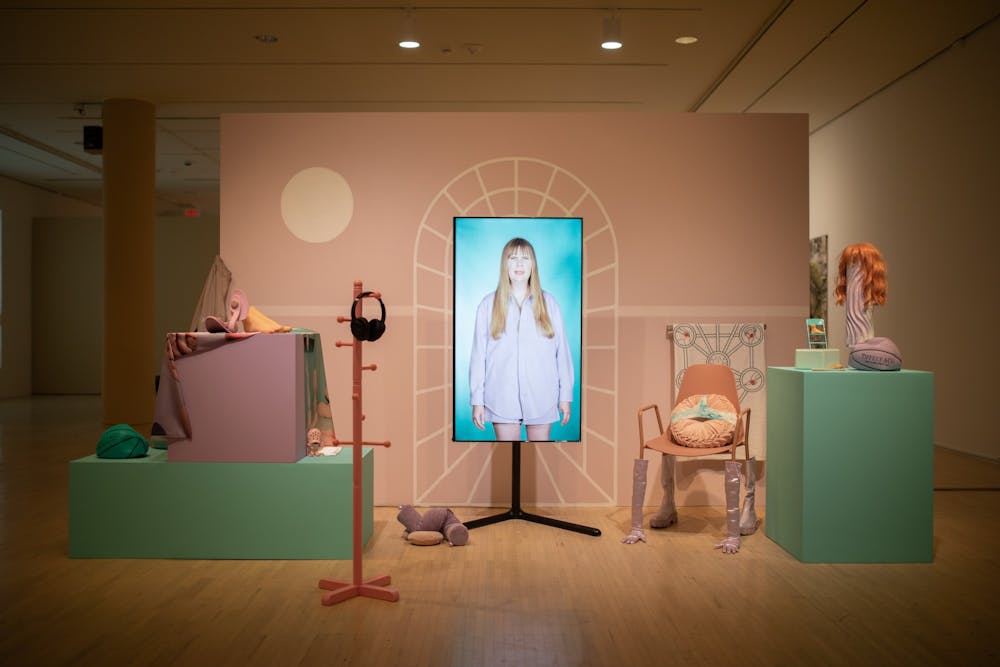The word “hospitality” connotes many things: warmth, friendliness, generosity. It conjures images of manicured guest rooms, of family gathered around a dinner table and of hotels and resorts. A hospitable person is accessible and welcoming, always making space for others — friends and strangers alike — in their home.
But “I don’t know you like that: The Bodywork of Hospitality” has a different take on the concept. It’s not about a billion-dollar industry or a set of folksy traditions — It’s about the human body, in all its bizarre and beautiful glory.
The newest exhibition at UB Art Galleries, which opened last week and will run until May 12, examines the biological, ethical and metaphysical implications of hospitality as it relates to human bodies.
“[The exhibition] invites us to consider how hospitality has simultaneously defined and confined what we think bodies are, what we imagine they can do… and, ultimately, how they engage with each other in the world,” Sylvie Fortin, the show’s curator, writes in the exhibition’s program.
In viewing the body as a “home,” (or, as Fortin puts it, “a prison-house of flesh and mind”) “I don’t know you like that” expands and subverts the definition of hospitality.
“My object, theoretically, is to free hospitality from the home, and to free hospitality from any notion of debt and duty,” Fortin said.
Argentinian artist Celina Eceiza’s work is one of the exhibition’s most vivid demonstrations of the human body as a home, as a place others can access.
Her piece “La vida terrenal reconquista al soñador,” (a title that translates to “earthly life reconquers the dreamer”) is a larger-than-life, labyrinthine installation modeled after the shape of a human kidney. Walking through a psychedelic, colorful space is meant to emulate traveling through a person’s organs.
With pillows and rugs scattered on the floor, the space feels welcoming and cozy — something Eceiza clearly intended. The artist said she wanted the installation to act as a safe, quiet space for “anyone who needs a place to read, or a place to be, or a place to do work.”
Eceiza’s piece is whimsical and humorous, framing the human body as a welcoming and communal structure.
Rodney McMillian’s piece, “Untitled (Entrails),” is one of the exhibition’s more confrontational works. The aptly-titled piece comprises large tubes of black fabric shaped like intestines, hanging from the ceiling by meat hooks.
It provokes discomfort, especially viewed in tandem with McMillian’s other piece “Between the Sun and the Moon (For H.A. Washington).” The painting lists, in bold capital letters, a timeline of non-consensual medical experiments inflicted on African Americans since the 1950s.
The “hospitality” in McMillian’s work is not the kind that is freely given, but forcibly taken. It’s a stark commentary on the violations of bodily autonomy that people of color have faced in the U.S.
Then there’s “Fighting for the title to not be pending” by First Nations artist Jeneen Frei Njootli. The piece is made of thousands of tiny glass beads that, when weighed together, equal the artist’s body weight. The beads are piled up in the corner of the gallery, but also distributed across the room, settled in cracks in the floor.
A visitor to the gallery may inadvertently step on the beads or kick them around; they spread across the floor and reach unexpected places, making the piece a mobile, living body that becomes a part of its environment.
French conceptual artist Jean-Charles de Quillacq’s work has a similar effect, blurring the lines between the human body and its surrounding architecture. “Souple ment,” a piece made of acrylic resin, is simply a pair of human feet sticking out from the gallery floor. Even more bizarre is “Ma Sis T’Aime Reproductive,” a coating of artificial sweat on the gallery wall.
An incredibly diverse collection of works, “I don’t know you like that: The Bodywork of Hospitality” elicits a wide range of reactions from the viewer. Some pieces provoke laughter, and some may cause shock and discomfort.
But every piece in the exhibition speaks volumes about the joys, pains and absurdities of inhabiting a human body.
The exhibition is open to the public at UB’s Anderson and CFA Galleries until May 12, 2023, and admission is free.
Meret Kelsey is the senior arts editor and can be reached at meret.kelsey@ubspectrum.com
Meret Kelsey is an assistant arts editor at The Spectrum.





